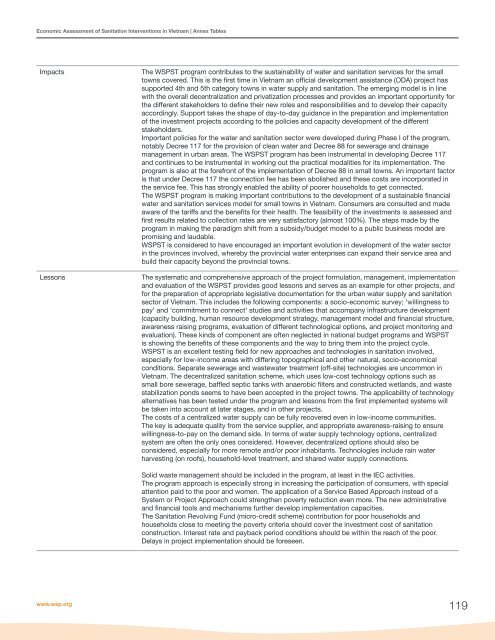Economic Assessment of Sanitation Interventions in Vietnam - WSP
Economic Assessment of Sanitation Interventions in Vietnam - WSP
Economic Assessment of Sanitation Interventions in Vietnam - WSP
Create successful ePaper yourself
Turn your PDF publications into a flip-book with our unique Google optimized e-Paper software.
<strong>Economic</strong> <strong>Assessment</strong> <strong>of</strong> <strong>Sanitation</strong> <strong>Interventions</strong> <strong>in</strong> <strong>Vietnam</strong> | Annex TablesImpactsLessonsThe <strong>WSP</strong>ST program contributes to the susta<strong>in</strong>ability <strong>of</strong> water and sanitation services for the smalltowns covered. This is the first time <strong>in</strong> <strong>Vietnam</strong> an <strong>of</strong>ficial development assistance (ODA) project hassupported 4th and 5th category towns <strong>in</strong> water supply and sanitation. The emerg<strong>in</strong>g model is <strong>in</strong> l<strong>in</strong>ewith the overall decentralization and privatization processes and provides an important opportunity forthe different stakeholders to def<strong>in</strong>e their new roles and responsibilities and to develop their capacityaccord<strong>in</strong>gly. Support takes the shape <strong>of</strong> day-to-day guidance <strong>in</strong> the preparation and implementation<strong>of</strong> the <strong>in</strong>vestment projects accord<strong>in</strong>g to the policies and capacity development <strong>of</strong> the differentstakeholders.Important policies for the water and sanitation sector were developed dur<strong>in</strong>g Phase I <strong>of</strong> the program,notably Decree 117 for the provision <strong>of</strong> clean water and Decree 88 for sewerage and dra<strong>in</strong>agemanagement <strong>in</strong> urban areas. The <strong>WSP</strong>ST program has been <strong>in</strong>strumental <strong>in</strong> develop<strong>in</strong>g Decree 117and cont<strong>in</strong>ues to be <strong>in</strong>strumental <strong>in</strong> work<strong>in</strong>g out the practical modalities for its implementation. Theprogram is also at the forefront <strong>of</strong> the implementation <strong>of</strong> Decree 88 <strong>in</strong> small towns. An important factoris that under Decree 117 the connection fee has been abolished and these costs are <strong>in</strong>corporated <strong>in</strong>the service fee. This has strongly enabled the ability <strong>of</strong> poorer households to get connected.The <strong>WSP</strong>ST program is mak<strong>in</strong>g important contributions to the development <strong>of</strong> a susta<strong>in</strong>able f<strong>in</strong>ancialwater and sanitation services model for small towns <strong>in</strong> <strong>Vietnam</strong>. Consumers are consulted and madeaware <strong>of</strong> the tariffs and the benefits for their health. The feasibility <strong>of</strong> the <strong>in</strong>vestments is assessed andfirst results related to collection rates are very satisfactory (almost 100%). The steps made by theprogram <strong>in</strong> mak<strong>in</strong>g the paradigm shift from a subsidy/budget model to a public bus<strong>in</strong>ess model arepromis<strong>in</strong>g and laudable.<strong>WSP</strong>ST is considered to have encouraged an important evolution <strong>in</strong> development <strong>of</strong> the water sector<strong>in</strong> the prov<strong>in</strong>ces <strong>in</strong>volved, whereby the prov<strong>in</strong>cial water enterprises can expand their service area andbuild their capacity beyond the prov<strong>in</strong>cial towns.The systematic and comprehensive approach <strong>of</strong> the project formulation, management, implementationand evaluation <strong>of</strong> the <strong>WSP</strong>ST provides good lessons and serves as an example for other projects, andfor the preparation <strong>of</strong> appropriate legislative documentation for the urban water supply and sanitationsector <strong>of</strong> <strong>Vietnam</strong>. This <strong>in</strong>cludes the follow<strong>in</strong>g components: a socio-economic survey; ‘will<strong>in</strong>gness topay’ and ‘commitment to connect’ studies and activities that accompany <strong>in</strong>frastructure development(capacity build<strong>in</strong>g, human resource development strategy, management model and f<strong>in</strong>ancial structure,awareness rais<strong>in</strong>g programs, evaluation <strong>of</strong> different technological options, and project monitor<strong>in</strong>g andevaluation). These k<strong>in</strong>ds <strong>of</strong> component are <strong>of</strong>ten neglected <strong>in</strong> national budget programs and <strong>WSP</strong>STis show<strong>in</strong>g the benefits <strong>of</strong> these components and the way to br<strong>in</strong>g them <strong>in</strong>to the project cycle.<strong>WSP</strong>ST is an excellent test<strong>in</strong>g field for new approaches and technologies <strong>in</strong> sanitation <strong>in</strong>volved,especially for low-<strong>in</strong>come areas with differ<strong>in</strong>g topographical and other natural, socio-economicalconditions. Separate sewerage and wastewater treatment (<strong>of</strong>f-site) technologies are uncommon <strong>in</strong><strong>Vietnam</strong>. The decentralized sanitation scheme, which uses low-cost technology options such assmall bore sewerage, baffled septic tanks with anaerobic filters and constructed wetlands, and wastestabilization ponds seems to have been accepted <strong>in</strong> the project towns. The applicability <strong>of</strong> technologyalternatives has been tested under the program and lessons from the first implemented systems willbe taken <strong>in</strong>to account at later stages, and <strong>in</strong> other projects.The costs <strong>of</strong> a centralized water supply can be fully recovered even <strong>in</strong> low-<strong>in</strong>come communities.The key is adequate quality from the service supplier, and appropriate awareness-rais<strong>in</strong>g to ensurewill<strong>in</strong>gness-to-pay on the demand side. In terms <strong>of</strong> water supply technology options, centralizedsystem are <strong>of</strong>ten the only ones considered. However, decentralized options should also beconsidered, especially for more remote and/or poor <strong>in</strong>habitants. Technologies <strong>in</strong>clude ra<strong>in</strong> waterharvest<strong>in</strong>g (on ro<strong>of</strong>s), household-level treatment, and shared water supply connections.Solid waste management should be <strong>in</strong>cluded <strong>in</strong> the program, at least <strong>in</strong> the IEC activities.The program approach is especially strong <strong>in</strong> <strong>in</strong>creas<strong>in</strong>g the participation <strong>of</strong> consumers, with specialattention paid to the poor and women. The application <strong>of</strong> a Service Based Approach <strong>in</strong>stead <strong>of</strong> aSystem or Project Approach could strengthen poverty reduction even more. The new adm<strong>in</strong>istrativeand f<strong>in</strong>ancial tools and mechanisms further develop implementation capacities.The <strong>Sanitation</strong> Revolv<strong>in</strong>g Fund (micro-credit scheme) contribution for poor households andhouseholds close to meet<strong>in</strong>g the poverty criteria should cover the <strong>in</strong>vestment cost <strong>of</strong> sanitationconstruction. Interest rate and payback period conditions should be with<strong>in</strong> the reach <strong>of</strong> the poor.Delays <strong>in</strong> project implementation should be foreseen.www.wsp.org119
















